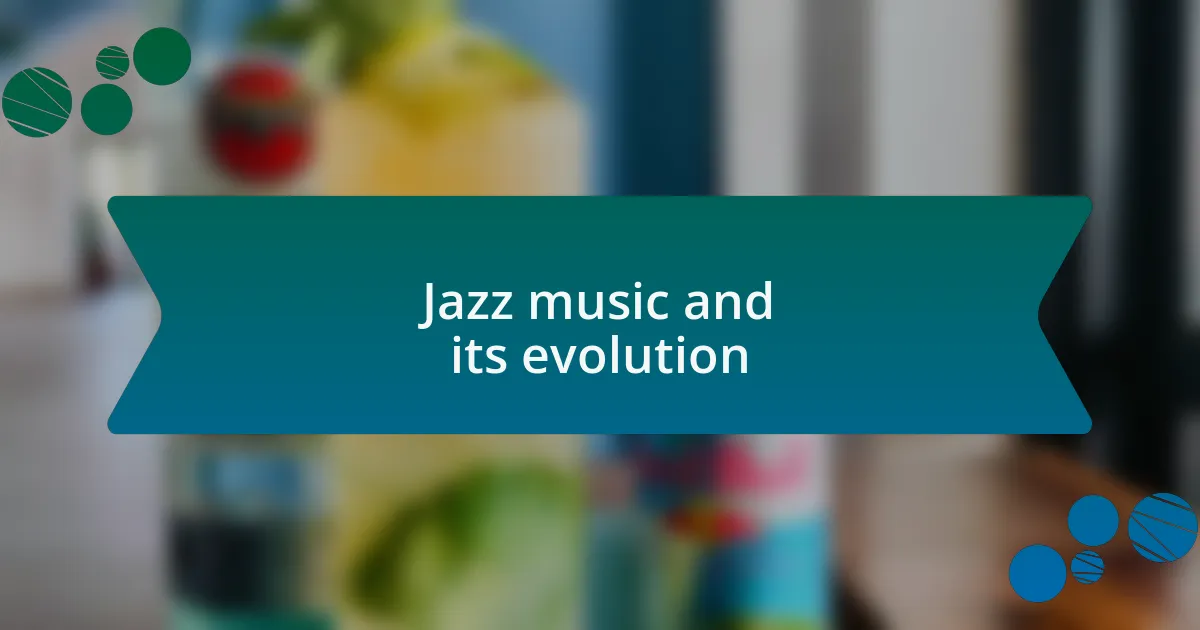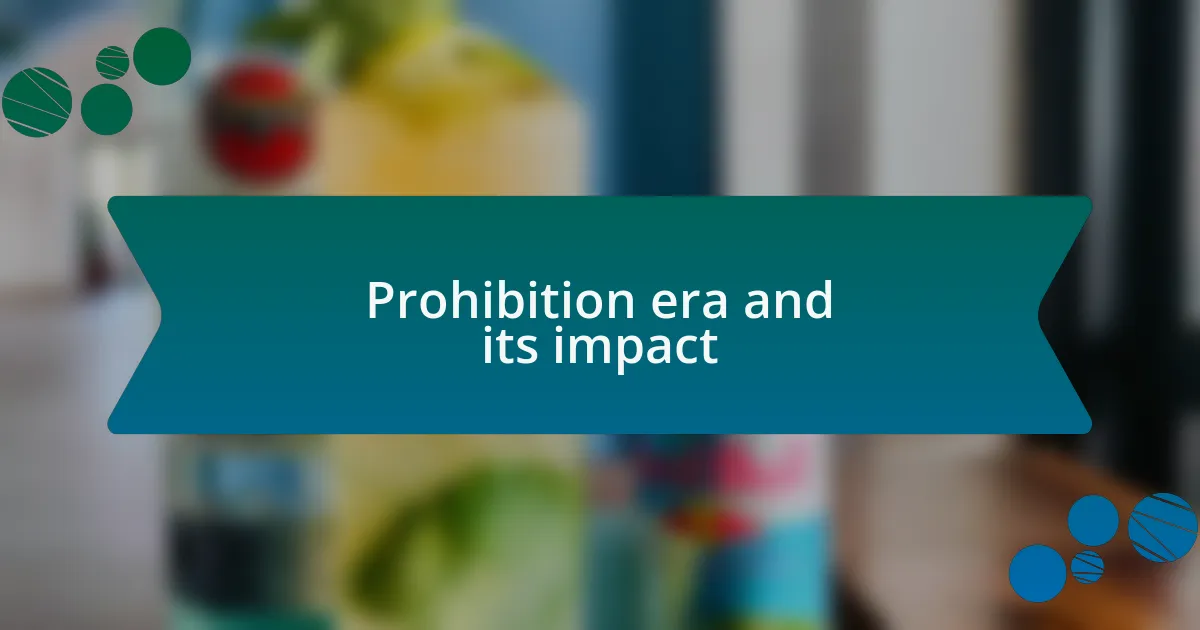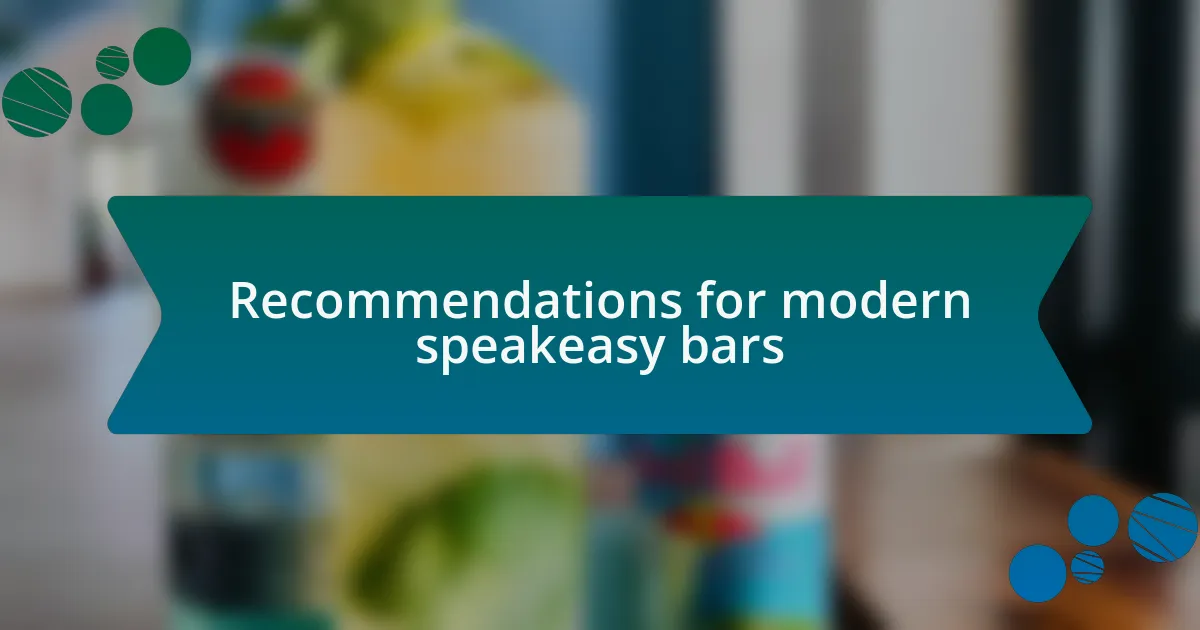Key takeaways:
- Speakeasy bars, rooted in the Prohibition era, offer a unique blend of history, creativity, and intimacy, often featuring hidden entrances and a vintage atmosphere.
- Jazz music played a significant role during Prohibition, serving as the soundtrack for clandestine gatherings, reflecting the rebellious spirit of the time.
- The Prohibition era led to the rise of organized crime and cultural movements, turning speakeasies into hubs of creativity and defiance against restrictions.
- Modern speakeasy bars should focus on authenticity, creative cocktails, and knowledgeable staff to enhance the nostalgic experience for patrons.

Understanding speakeasy bars
Speakeasy bars hold a special allure, tapping into a rich history and the rebellious spirit of the Prohibition era. I remember stepping into my first speakeasy, the dim lighting and vintage decor instantly transporting me back in time. It’s fascinating how these hidden gems evoke a sense of adventure—how many of us crave a little secrecy in our lives?
A speakeasy isn’t just about the cocktails; it’s an experience steeped in a fascinating narrative. The thrill of finding a hidden entrance captivates the imagination, provoking the question: what stories lie behind those closed doors? Each visit feels like stepping into a living history lesson where I can almost hear the jazz music from a bygone era filling the air.
Moreover, the creative cocktails often reflect the bar’s character and the era it represents. During one of my visits, the bartender shared the story behind a signature drink—how it symbolizes resilience during a time when alcohol was forbidden. This connection to the past makes each sip even more enjoyable as I ponder how people defied the odds for a taste of freedom, don’t you think?

History of speakeasy bars
Speakeasy bars emerged in the early 20th century, particularly during the Prohibition era from 1920 to 1933, when the sale of alcohol was outlawed in the United States. I remember reading about how clever owners set up secret entrances and hidden rooms to bypass law enforcement, transforming ordinary venues into clandestine gatherings for those craving a drink. It makes you wonder about the lengths people would go to just for a taste of something forbidden.
As I explored these hidden bars, I was struck by the stories etched into the very walls, tales of patrons huddled in shadows, sharing laughter and conversations over their contraband drinks. The name “speakeasy” itself reflects the period—ask for a drink too loudly, and you might draw unwanted attention. It’s fascinating to think about how this culture of secrecy and camaraderie gave rise to an atmosphere filled with jazz music, vibrant spirits, and a dash of danger. Have you ever felt that thrill, like you were part of a rebellious club, simply by stepping through the entrance?
After Prohibition ended, many speakeasies either adapted or vanished, but their legacy continues to influence modern cocktail culture. Walking into a contemporary speakeasy often feels like connecting with a piece of history—each cocktail sip reminiscent of defiance and creativity from a time when people sought freedom in the face of restrictions. I cherish how these bars celebrate that spirit, serving up history one drink at a time, don’t you?

Jazz music and its evolution
Jazz music has come a long way since its origins in the early 20th century, evolving into a vibrant tapestry of sounds that reflect the cultural shifts of America. I remember my first encounter with a classic jazz record; the rhythm seemed alive, pulsating with the spirit of the times. I’ve often wondered how jazz, born in the New Orleans clubs, managed to spill over into every corner of the country, influencing everything from dance halls to speakeasies.
In the 1920s, jazz emerged as the soundtrack to the Prohibition era, filling the secretive spaces of speakeasies where patrons sought refuge from the law. I recall being captivated by how the improvisational nature of jazz mirrored the rebelliousness of that time. It’s like each musician was a storyteller, weaving tales of joy and sorrow, often reflecting the very struggles of those who listened. Have you ever felt that connection, letting each note wash over you like a shared secret?
As jazz spread across America, it transformed with new influences, giving rise to sub-genres like swing and bebop. I still find it remarkable how this music, synonymous with the thrill of underground life, found its way into concert halls and mainstream culture. Every time I hear a nostalgic tune, I think about all those who danced the night away in dimly lit bars, celebrating freedom one note at a time. Isn’t it incredible how music can capture the essence of an era?

Prohibition era and its impact
The Prohibition era, lasting from 1920 to 1933, fundamentally reshaped American society, thrusting underground culture into the limelight. It’s fascinating to think about how laws intended to curb alcohol consumption led to a surge in organized crime and a parallel rise in the popularity of speakeasies. Imagine sneaking into a hidden bar, the thrill palpable in the air, where jazz played on and on, a soundtrack to both rebellion and camaraderie.
I often reflect on the lively gatherings that occurred in those clandestine venues, where jazz musicians became the heartbeat of resistance against a stifling regime. The atmosphere was electric; the blend of smoky air, laughter, and saxophone notes created an environment that felt alive and defiant. Don’t you think it’s ironic that something meant to restrict actually fostered a creative explosion instead?
As jazz flourished amidst the prohibition, it became more than music; it was a statement of freedom and expression for many. Those notes and rhythms captured the struggle and resilience of a generation, revealing deep emotions that connected people through the shared experience of defiance. Can you imagine the stories behind each song, echoing the lives of those who danced and toasted in secrecy, celebrating liberty in a glass?

Recommendations for modern speakeasy bars
When considering modern speakeasy bars, I highly recommend searching for those that embrace authenticity. Look for venues that pay homage to the Prohibition era, such as vibrant jazz music, hidden entrances, and an intimate atmosphere. I remember stepping into a bar behind a bookcase in the heart of the city; the moment I entered, I felt transported back in time, surrounded by vintage decor and dim lighting that set the perfect stage for a memorable night.
Another aspect to look for is the creativity of the cocktail menu. Many of these bars craft drinks with historical flair, mixing classic recipes with contemporary twists. One of my favorite experiences was tasting a gin fizz that was both refreshing and reminiscent of the 1920s, all while I savored the sounds of live jazz in the background. Isn’t it incredible how a well-prepared drink can evoke such strong memories and emotions?
Lastly, don’t underestimate the power of the staff’s knowledge. A good speakeasy should have bartenders who not only mix a mean cocktail but also weave stories that enrich the experience. Asking them about their favorite drink can lead to delightful conversations that make your visit unforgettable. It’s those personal touches, the ability to share a laugh or a story, that really takes a night out at a speakeasy to a whole new level.